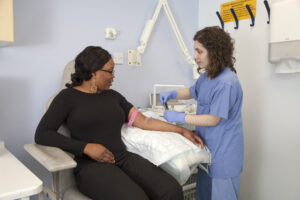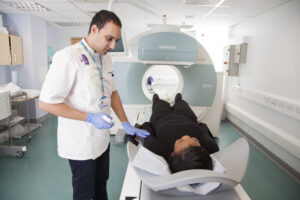Nuclear medicine scan
This is also known as a radionuclide scan. It involves having a chemical put into your body that can be picked up by a scanner, similar to having a contrast dye for a CT or MRI scan. But in this case, the chemical – known as a tracer or radionuclide – is radioactive. The tracer gives off a type of radioactivity called gamma rays.
Certain tumours and areas of your body absorb specific chemicals. These chemicals are made mildly radioactive and then put into your bloodstream. Because the tumours and/or the area of your body absorb the substance which is giving off gamma rays, they show up on the scan.
For example, if you have radioactive iodine injected into a vein, the tissues of your thyroid gland quickly absorb it. So, it is used to take images of your thyroid gland.
The dose of radioactivity you get is very low (about the same as you get from an x-ray). Almost all of it leaves your body within a few days.
What is it used for?
In certain cancers, it enables us to get a good idea of where the tumours are, their size and their structure. We may use this test to find where the cancer started (the primary tumour), or to check for any spread of the disease (secondaries or metastases).
Types of nuclear scan include:
- bone scan
- DMSA kidney scan
- MAG3 renogram
- lung scan
- MIBG scan
- thyroid scan
- octreotide scan.
Do I need to prepare?
If you are pregnant, or think you may be pregnant, please tell us before your scan. Even small amounts of radiation can harm unborn babies.
You can have the scan if you are breastfeeding, but please contact us for advice before you come in for your test.
In most cases you do not need to prepare for the scan. But if you do, the details will be included in your appointment letter; it is important you follow these instructions to ensure we can take good-quality pictures. For most tests you do not need to change any regular treatment. We will tell you if you do need to stop taking any medication.
What happens during the procedure?
First, a small amount of the radioactive substance is injected into a vein in your arm or hand. You may then be scanned straight away or be asked to wait for a few hours before we can take the pictures. This will depend on the type of scan.

During the scan you have to remain still on a bed while a gamma camera takes pictures of the tracer in your body. The camera will be quite close to you at the area of interest so it can take good-quality pictures.

There are different types of scan you may have are, depending on your condition:
- static scan: the camera will be positioned over one area of your body
- whole body scan: the camera will slowly move from your head to your toes
- SPECT scan: the camera will rotate slowly around you
- SPECT/CT scan: Following the SPECT scan, the camera will rotate slowly around you, a CT scan is performed on the same scanner.
You can go home after your scan.
Contact us
If you have any queries about your scan please contact us on the relevant phone number below:
King’s College Hospital: 020 3299 3153
Radiology at Princess Royal University Hospital (PRUH): 01689 863642 / 01689 863673 / 01689 863674 / 01689 863675
